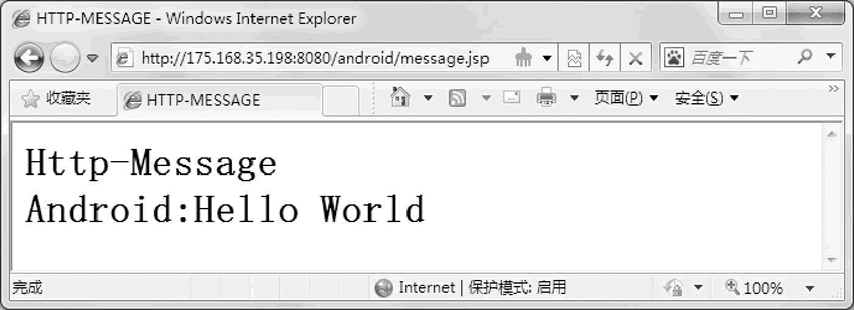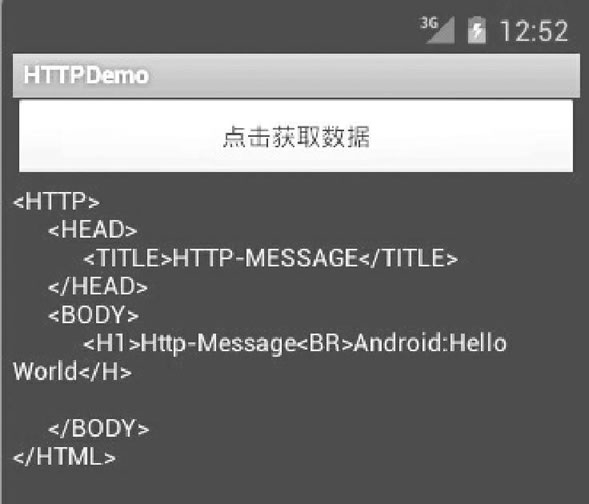Android HttpURLConnection访问互联网资源
为了可以通过 AVD 调试网络访问应用程序,首先在本地计算机上架设网络服务器端。使用 Tomcat 做服务器,在其 webapps 目录下建立 android 目录,并在该目录下建立 message.jsp 文件。

图 1 message.jsp 的运行效果
这样,我们就有了可以通过 AVD 来访问的网络上的资源。
使用 java.net.URLConnection 访问 URL 指定的网络资源的基本过程的代码如下:
在创建连接之前,可以对连接的一些属性进行设置,如下表所示。
HttpURLConnection 继承于 URLConnection 类,二者都是抽象类,所以无法直接实例化,其对象主要通过 URL 的 openConnection 方法获得。
URLConnection 可以直接转换成 HttpURLConnection,以便于使用一些 HTTP 连接特定的方法,如 getResponseMessage()、setRequestMethod() 等。
使用 HttpURLConnection 访问网络资源的基本过程的代码如下:
实例 URLDemo 中演示了使用 URL 访问指定资源的过程,运行效果如图 2 所示。

图 2 URLDemo 的运行效果
实例 URLDemo 中 main.xml 的代码如下:
<HTTP>
<HEAD>
<TITLE>HTTP-MESSAGE</TITLE>
</HEAD>
<BODY>
<%
OUT.PRINTln("<H1>Http-Message<BR>Android:Hello World</H>");
%>
</BODY>
</HTML>
由于本地计算机在网络上的 IP 为 175.168.35.198,因此 message.jsp 的网络 URL 为 http://175.168.35.198:8080/android/message.jsp。将该地址输入 IE 地址栏打开,其运行效果如图 1 所示。
图 1 message.jsp 的运行效果
使用 java.net.URLConnection 访问 URL 指定的网络资源的基本过程的代码如下:
URL url=new URL("ftp://mirror.csclub.uwaterloo.ca/index.html");//建立URL
URLConnection urlConnection=url.openConnection();//打开连接
InputStream in=new BufferedInputStream(
urlConnection. getlnputStream());//从连接建立输入流
try {
readstream (in); //读取数据操作
}finally{
in.close();
}
}
URLConnection 内建对多种网络协议的支持,如 HTTP/HTTPS、File、FTP 等。在创建连接之前,可以对连接的一些属性进行设置,如下表所示。
| 属性名称 | 属性描述 |
|---|---|
| setReadTimeout(3000) | 设置读取数据的超时时间为 3 秒钟 |
| setUseCaches(false) | 设置当前连接是否允许使用缓存 |
| setDoOutput(true) | 设置当前连接是否允许建立输出流 |
| setDoInput(true) | 设置当前连接是否允许建立输入流 |
HttpURLConnection 继承于 URLConnection 类,二者都是抽象类,所以无法直接实例化,其对象主要通过 URL 的 openConnection 方法获得。
URLConnection 可以直接转换成 HttpURLConnection,以便于使用一些 HTTP 连接特定的方法,如 getResponseMessage()、setRequestMethod() 等。
使用 HttpURLConnection 访问网络资源的基本过程的代码如下:
URL url=new URL("http://www.android.com/");
HttpURLConnection urlConnection=(HttpURLConnection)url.openConnection();
try {
InputStream in=new BufferedInputStream(urlConnection.getInputStream());
readstream(in);
}finally{
urlConnection.disconnect();
}
需要注意的是,使用 openConnection 方法所创建的 URLConnection 或者 HttpURLConnection 实例不具有重用性,每次调用 openConnection 方法都将创建一个新的实例。实例 URLDemo 中演示了使用 URL 访问指定资源的过程,运行效果如图 2 所示。

图 2 URLDemo 的运行效果
实例 URLDemo 中 main.xml 的代码如下:
<?xml version="1.0” encoding="utf-8"?>
<LinearLayout
xmlns:android="http://schemas.android.com/apk/res/android"
android:orientation="vertical"
android:layout_width="fill_parent"
android:layout_height="fill_parent">
<Button
android:id="@+id/Button_HTTP"
android:layout_width="fill_parent"
android:layout_height="wrap_content"
android:text="@string/button_name01"/>
<TextView
android:id="@+id/TextView_HTTP"
android:layout_width="fill_parent"
android:layout_height="wrap_content"/>
</LinearLayout>
实例 URLDemo 中 AndroidManifest.xml 的代码如下:
<?xml version="l.0" encoding="utf-8"?>
<manifest xmlns:android="http://schemas.android.com/apk/res/android"
package="com.android.activity"
android:versionCode="1"
android:versionName="1.0">
<uses-sdk android:minSdkVersion="4" />
<uses-permission android:name="android.permission.INTERNET" />
<application android:icon="@drawable/ic_launcher"
android:label="@string/app_name">
<activity android:name=".MainActivity"
android:label="@string/app_name">
<intent-filter>
<action android:name="android.intent.action.MAIN" />
<category android:name="android.intent.category.LAUNCHER" />
</intent-filter>
</activity>
</application>
</manifest>
实例 URLDemo 中 MainActivity.java 的具体实现代码如下:
package introdction.android.URLDemo;
import java.io.BufferedReader;
import java.io.IOException;
import java.io.InputstreamReader;
import java.net.HttpURLConnection;
import java.net.MalformedURLException;
import java.net.URL;
import com.android.activity.R;
import android.app.Activity;
import android.os.Bundle;
import android.view.View;
import android.view.View.OnClickListener;
import android.widget.Button;
import android.widget.TextView;
public class MainActivity extends Activity {
/** Called when the activity is first created. */
private TextView textView_HTTP;
@Override
public void onCreate (Bundle savedInstanceState) {
super.onCreate (savedInstanceState);
setContentView (R.layout.main);
textView_HTTP= (TextView) findViewById (R.id.TextView_HTTP);
Button button_http= (Button) findViewById (R.id.Button_HTTP) ;
button_http. setOnClickListener (new OnClickListener () {
//给button_http按钮设置监听器
public void onClick (View v) {//事件处理
String httpUrl="http://175.168.35.198:8080/android/message.jsp";
String resultData="";//定义一个resultData用于存储获得的数据
URL url=null; //定义URL对象
try {
url=new URL (httpUrl); //构造一个URL对象时需要使用异常处理
} catch (MalformedURLException e) {
System.out.println (e.getMessage ());//打印出异常信息
}
if (url !=null) {//如果URL不为空时
try{
//有关网络操作时,需要使用异常处理
HttpURLConnection urlConn= (HttpURLConnection)url.openConnection (); //使用HttpURLConnection打开连接
InputStreamReader in=new InputStreamReader (urlConn.getInputStream());//得到读取的内容
BufferedReader buffer=new BufferedReader (in);//为输出创建BufferedReader
String inputLine=null;
while (((inputLine=buffer.readLine()) !=null)) {
// 读取获得的数据
resultData+=inputLine+"\n"; // 加上"\n"实现换行
}
in.close();//关闭InputStreamReader
urlConn.disconnect(); //关闭HTTP连接
if (resultData !=null) {//如果获取到的数据不为空
textView_HTTP.setText(resultData) ;
} else {
textView_HTTP.setText("Sorry,the content is null");//获取到的数据为空时显示
}
} catch (IOException e) {
textView_HTTP.setText (e.getMessage());
//出现异常时,打印异常信息
}
} else {
textView_HTTP.setText ("url is null"); //当url为空时输出
}
}
}) ;
}
以上代码中,
String httpUrl = "http://175.168.35.198:8080/android/message.jsp ";
指定了要访问的网络资源的地址,测试时改成自己本机的IP地址即可。所有教程
- C语言入门
- C语言编译器
- C语言项目案例
- 数据结构
- C++
- STL
- C++11
- socket
- GCC
- GDB
- Makefile
- OpenCV
- Qt教程
- Unity 3D
- UE4
- 游戏引擎
- Python
- Python并发编程
- TensorFlow
- Django
- NumPy
- Linux
- Shell
- Java教程
- 设计模式
- Java Swing
- Servlet
- JSP教程
- Struts2
- Maven
- Spring
- Spring MVC
- Spring Boot
- Spring Cloud
- Hibernate
- Mybatis
- MySQL教程
- MySQL函数
- NoSQL
- Redis
- MongoDB
- HBase
- Go语言
- C#
- MATLAB
- JavaScript
- Bootstrap
- HTML
- CSS教程
- PHP
- 汇编语言
- TCP/IP
- vi命令
- Android教程
- 区块链
- Docker
- 大数据
- 云计算